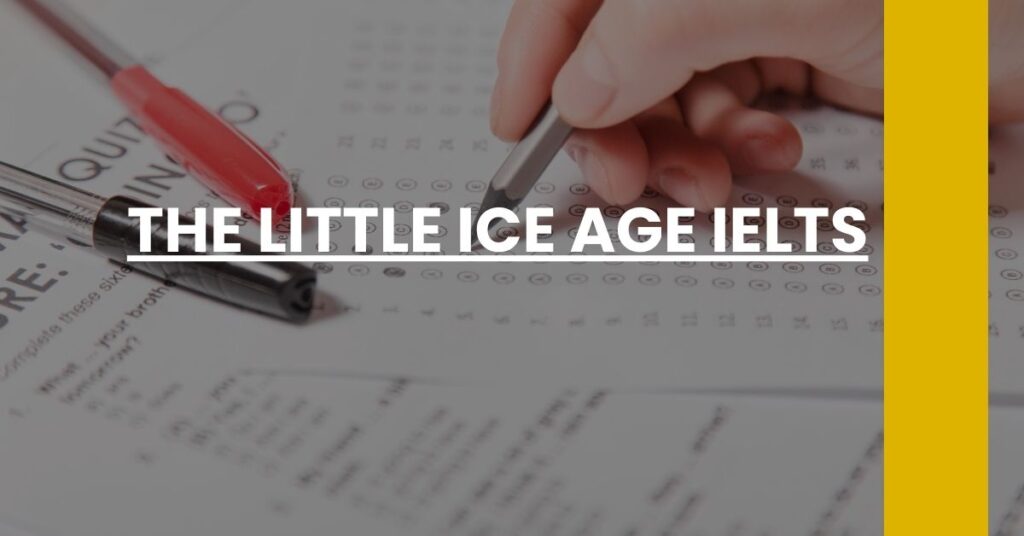The Little Ice Age refers to a period of cooler climate and harsh winters that affected much of the world from approximately the 14th to the 19th century. Especially noted in IELTS readings, this climatic event offers valuable insights into human adaptation to changing environments.
In your pursuit of IELTS success, understanding historical phenomena like the Little Ice Age is key. It equips you with knowledge to tackle reading passages about climatic events and their impact on societies.
This article will guide you through:
- The significance of the Little Ice Age in shaping agricultural and societal changes
- Interpreting related IELTS reading topics
Reading on, you’ll find the tools necessary to grasp not just “what” the Little Ice Age was, but also its paramount importance for IELTS preparedness.
- Introduction to the Little Ice Age
- Historical Significance of the Little Ice Age
- Causes of the Little Ice Age
- Effects on Agriculture and Society
- The Little Ice Age in IELTS Readings
- Examining Evidence Using IELTS Critical Reading Skills
- Important Vocabulary Related to the Little Ice Age
- Scientific and Historical Consensus Today
- Preparing for the IELTS with Historical Topics
- Conclusion: Implications for IELTS Test Takers
Introduction to the Little Ice Age
When you delve into the pages of Earth’s climatic history, you will encounter a curious episode known as the Little Ice Age. Spanning roughly from the 1300s to the mid-19th century, this period was marked by a noticeable dip in global temperatures. If this term is new to you, imagine a time when the Thames River in London routinely froze, allowing frost fairs to be held on its icy surface, and when Alpine glaciers advanced, threatening European valleys. Far from simply an anecdote of historical weather trivia, the Little Ice Age has profound lessons embedded within it; it showcases the resilience and adaptability of human societies in the face of climatic adversity.
As you prepare for exams like the IELTS, you’ll find that understanding the Little Ice Age can enrich your grasp of how climate can shape culture, economies, and human history—a testament to the interconnectedness of our world.
Historical Significance of the Little Ice Age
You might wonder why the Little Ice Age merits your attention. Simply put, this period redefined entire civilizations: it sculpted landscapes, dictated agricultural yields, and influenced key historical events. For instance, during this time, artwork like the winter landscapes of Pieter Bruegel the Elder provided more than just visual splendor—they offered real insights into the lives of Europeans during colder climates. Additionally, the maritime expansion that led to the ‘Age of Discovery’ was also colored by the challenges and opportunities presented by this cooler period.
Imagine societies grappling with a series of harsh winters, or farmers facing the task of growing crops in suddenly unforgiving conditions. The Little Ice Age wasn’t just a slight dip in temperatures; it tested the human spirit and ingenuity, leading to pivotal changes in land use and agricultural practices that resonate to this very day. As a student or scholar, recognizing the historical significance of these climatic events can enhance your understanding and appreciation of history’s complexity, a skill that’s invaluable for acing sections like the IELTS Reading.
Causes of the Little Ice Age
Diving deeper, you might ask: what catalyzed this significant cooling? Researchers, much like detectives, have pieced together evidence pointing towards a cocktail of causes. Foremost among these were volcanic activity that sent sun-blocking ash into the atmosphere, and periods of reduced solar radiation, the sun’s temperamental nature affecting Earth’s climate. Further stirring the mix were alterations in ocean currents, which play a crucial role in distributing heat across our planet’s surface.
For you, as a learner, teasing out the intricate causes of the Little Ice Age is akin to honing your analytical abilities. By dissecting complex causes and their cascading effects, you fine-tune your critical thinking—a skill that’s crucial not only for environmental topics on exams like the IELTS but also for broadly assessing multifaceted issues.
Effects on Agriculture and Society
The reach of the Little Ice Age extended well into the grain fields and marketplaces of the time. In Northern Europe, sporadic harvests and grain shortages became the norm, the sting of famine more common than before. Across the Atlantic, colonial settlements in North America also faced their share of cold-induced hardships. This era, characterized by crop failures and the subsequent socio-economic stress, underscores the profound relationship between climate and societal stability.
As you explore such impacts, you’re not merely learning facts for the IELTS; you’re understanding the ripple effect in human history. Recognizing the connections between the environment and societal changes can sharpen your analysis on a range of IELTS topics, ensuring you’re well-prepared to tackle questions with both depth and context.
The Little Ice Age in IELTS Readings
Within the context of IELTS readings, the Little Ice Age emerges as a compelling case study. The texts you’ll encounter may use this period to unravel discussions on climate change, demonstrate the human response to environmental shifts, or illustrate the broad strokes of historical adaptation to global phenomena. The nuanced understanding you develop about this period could serve as a springboard for insights on contemporary climate discussions—a theme that is increasingly prevalent in academic discourse and, by extension, the IELTS.
The ability to weave historical knowledge with current issues reflects a learner’s adaptability and awareness of the timeless relevance of past events. By familiarizing yourself with the Little Ice Age, you are juxtaposing the past with the present, a synthesis that exemplifies the advanced comprehension the IELTS often demands. This nuanced approach ensures you’re not only absorbing historical facts but also applying them to present-day scenarios effectively.
Examining Evidence Using IELTS Critical Reading Skills
Delving into historical climatic phenomena like the Little Ice Age sharpens your adeptness in scrutinizing the evidence—a critical skill for excelling in the IELTS Reading section. When encountering passages on topics such as the Little Ice Age, you must weigh the credibility of sources, distinguish between main ideas and supporting details, and infer meaning from context. By applying these reading and analytical skills, you can dissect complex texts, evaluate different viewpoints, and synthesize information—a testament to your readiness for challenging IELTS passages.
Consider a passage describing the societal impacts of the Little Ice Age. Using your IELTS-developed reading skills, you would analyze the author’s arguments, discern cause-and-effect relationships, and assess the validity of provided evidence. By engaging in practice readings on such topics, you transform reading from a passive activity into an active investigative process, honing the precise skills that the IELTS demands.
Tips for Examining Evidence:
- Identify the hypothesis – What is the passage claiming about the Little Ice Age?
- Evaluate the evidence – Does the author present data, examples, or expert testimony to support their claims?
- Analyze the logic – Are the arguments coherent and logical? Can you detect any reasoning fallacies?
Skilled interpretation and analysis of evidence will not only enhance your proficiency in tackling similar IELTS readings but will also prepare you to grapple intelligently with a myriad of complex topics beyond the exam.
Important Vocabulary Related to the Little Ice Age
Throughout your IELTS preparation, becoming familiar with the vernacular surrounding the Little Ice Age is incredibly beneficial. Comprehending key terms can significantly aid your reading comprehension and enable you to address relevant topics with finesse. Here, we’ve identified a handful of crucial phrases that encapsulate this period and might surface in your examination readings:
- Glacial Advance – The movement of glaciers, which was notable during the Little Ice Age.
- Maunder Minimum – A period of low sunspot activity roughly corresponding to the coldest phase of the Little Ice Age.
- Frost Fairs – Public festivities held on the frozen surfaces of rivers during extreme winter cold.
- Subsistence Crisis – A situation where food production or distribution fails to meet the population’s needs, often exacerbated during the Little Ice Age.
Mastering the language specific to this era is not just about memorization but about understanding the phenomena they represent. This enhances your ability not only to grasp complex ideas but also to articulate them effectively, both in the IELTS test and in intellectual discussions.
Scientific and Historical Consensus Today
With ongoing scholarly discourse, the consensus surrounding the Little Ice Age has evolved. Today, it is widely accepted that this period entailed a complex web of causes, including but not limited to volcanic aerosols and reduced solar activity. This environmental ballet resulted in the considerably cooler climate that characterized the era.
In contemporary dialogue, the Little Ice Age serves as a crucial case study for understanding human interaction with climate change. Scientists continue to explore the multifaceted causes, seeking insights into current global warming trends. Understanding this progressive discourse on the Little Ice Age equips you to critically engage with the dynamism of scientific discovery—a reflection of the critical thinking celebrated by the IELTS.
Preparing for the IELTS with Historical Topics
So, how exactly can thrilling historical chapters like the Little Ice Age bolster your IELTS preparation? Through integrating such topics into your study routine! This strategy involves not just passive reading but also active discussion, writing practice, and vocabulary enhancement. Here’s a breakdown of how historical topics can enrich your IELTS journey:
- Reading Comprehension: Delve into academic articles or books about the Little Ice Age. This will familiarize you with complex texts and specialized vocabulary.
- Discussion Practice: Engage in dialogues or debates about the era’s impacts, perfecting your speaking abilities.
- Writing Enhancement: Craft essays that explore the Little Ice Age’s multifaceted influences, thus improving your written articulation and argument structure.
By intertwining the rich tapestry of history with your exam preparations, you gain a dual advantage: acing the IELTS and expanding your intellectual horizons.
Conclusion: Implications for IELTS Test Takers
Understanding the nuances of historical phenomena like the Little Ice Age and their presentation in IELTS materials not only better positions you to tackle the reading section but also sharpens your overall analytical acumen. This preparatory avenue invites you to step beyond memorizing facts into a world where you must dissect, debate, and decide—a skill set that transforms you into a global thinker ideally suited for the challenges of the IELTS and far beyond.
In your quest to conquer “the little ice age IELTS” passages, you’ll be navigating a confluence of history, science, and language. So revel in the complexity of the past, for it lays the groundwork for your future success.
Explore “The Little Ice Age IELTS” resources for insights on climatic impact and historical significance for exam success.

